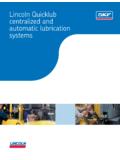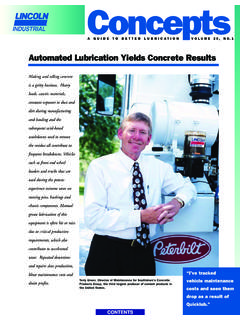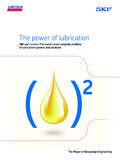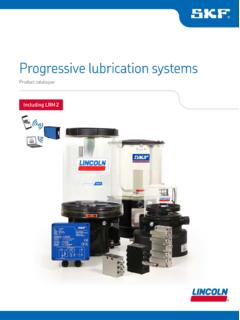Transcription of Troubleshooting Guide for the Lincoln QuicklubÒ …
1 1 12703 Pennridge Dr. ** Bridgeton, MO 63044 (314) 291-9600 for Tech. Support (314) 291-9601 FAX Troubleshooting Guide for the Lincoln quicklub Automatic Lubrication System ** Some of the Troubleshooting tips in this Guide may only work with systems designed and installed by Mobile Equipment, Inc. The Lincoln quicklub system is designed to be a preventative maintenance system that will extend the life of your bearings that are connected to it. Unfortunately, I would be lying if I said that this is a system that you can put on and completely forget about. There are three areas that the operator needs to be aware of and watch out for. I will talk about each of these areas and give all possible problems and solutions for them. 1) Pump: Make sure that the pump has grease in it. This is by far the most common problem. The reservoir is clear all the way around and the pump is usually located in an easy to see location.
2 Operators need to make sure that the pump always has grease in it. Fill the pump with grease. 2 liter pumps have one grease fitting on the pump to fill it with. 4 and 8 liter pumps have that fitting and a spin-off top. It is important to remember not to put dirty grease or any other contaminants in the pump. Contaminants in the grease could cause a block to lock up or the check valve in the pump element to fail. If you have a 2 or 4 liter pump that is continuously running out of grease, you may wish to upgrade to a larger reservoir. 2) Broken Lines: Since we are using a type 2 grease in most applications, any broken lines will be very evident. Fresh grease will start to accumulate. Remember, if a line breaks or is leaking for any reason, all of the points being fed by that line are not getting greased. Unless it is a main line or primary line, it will only affect one grease fitting.
3 The rest of the system will still work fine. Regardless, the line needs to be fixed ASAP. DO NOT PLUG LINES ON THIS SYSTEM! If it looks like the broken line was a fluke and will probably never happen again, then just fix the line. If you can see that this could happen again, you need to find a way to route the line so that it is not in harms way again. In some instances, it may be necessary to weld protective armor onto the machine to protect the line. If you have questions about how to protect the line, you can call your Lincoln representative for technical support. Abrasions may have caused the leak. In this instance, you can either reroute the line, tie it down, or put steel coil around the line to protect it. 3) Pressure Relief Valve is Leaking: This indicates that there is a point on the system that is not accepting grease. The quicklub System will not bypass, so it is pumping 3500 psi to the point to get it to take grease.
4 The pressure relief valve is designed to give a visual indication that there is a problem. It should be located in a prominent spot. When the pressure relief valve is discharging, your grease system is no longer getting grease to the bearings. All of the grease is discharging instead of bursting your lines. This can be caused by a number of things. If you do the following test you can quickly locate the source of the problem. Using a hand held grease gun, go to each of the secondary valves and grease the fitting on them. If there is no problem with the valve that you are on, it will be easy to pump. If you find that one of them is hard to pump, do not try to force it. The grease gun that you are using can build up to 11,000 psi of pressure. The hose is only rated for 3,500 psi. You can use an automatic grease gun but I do not recommend it. You cannot tell how much pressure that you are building up unless you listen to the frequency of the air releases from the pump.
5 It is very easy to put too much pressure to the hose this way. If too much pressure is applied to the hose it can explode and become dangerous to anyone standing near. Assuming one of the valves does not take grease, detach the line at the bearing of each of the points connected to that divider valve. In most case there are swivels attaching the hose at the grease point. Just loosen the swivel or back out the fitting. If you detach the one that is giving you problems, it will begin to ooze grease. Remember that it has a lot of pressure on it. The grease will not shoot out, but it will get all over very quickly. If this happens, then you have located the problem. You can dig in the fitting hole to see if it is clogged but normally the bearing is not taking grease. Sometimes you can blow the bearing out with a port-a-power, but sometime the pin and bushing may need to be removed to clear the passage to the bearing.
6 If you found a valve that will not take grease, but none of the lines are under pressure, then you have two options. It is either the valve itself or on of the fittings (rarely). Disconnect the hoses at the valve. Some hoses will thread out of the valve. Quicklincs (push to connect tube fittings) aren t as easy to remove but they do swivel. Do not try to remove the tube from the Quicklincs. In this case, it is much easier just to unscrew the Quicklincs from the valve without disconnecting the tube from the Quicklinc. Remember to put them back in the same holes that they came out of. ALL HOSES MUST BE RECONNECTED TO THE FITTINGS YOU REMOVED THEM FROM. 2 12703 Pennridge Dr. ** Bridgeton, MO 63044 (314) 291-9600 for Tech. Support (314) 291-9601 FAX Once you remove the Quicklincs, use the grease gun to test the valve. If the valve take grease with no hoses attached, the problem is in a hose or a fitting.
7 Check each hose by putting the Quicklincs back in the valve one at a time and testing the valve. This will pinpoint the problem hose. If this is the problem, you should find that the tube is pinched, kinked or a hose fitting is not properly drilled through. If you disconnect the Quicklincs and the valve still will not cycle, then the problem is in the valve. This is almost always caused by contamination or separation of grease. You can muscle down on the grease gun to get the valve to cycle. You can do this only if there are no grease lines connected to the valve. The pistons in the valve are machine fitted for each hole and only fit one way. If you tested all of the valves and none of them were hard to cycle, then the problem is in the primary valve. Remove the lines on the primary valve and put a grease fitting on the top of it and try to flush it out with a hand or automatic grease gun.
8 If this does not work then you will need to send it to your Lincoln dealer to be cleaned or buy another divider valve. You should set the timer on the pump to 0 on the red and blue dial to stop it so that it is not pouring grease all over. You can still grease the rest of the system from the grease fittings on the secondary valves. There are check valves in the fittings going to the secondaries to prevent the grease from backing out. Do not block off lines that are broken or lines where secondary valves are removed. This will cause the system to shut down because the grease will not be able to go where it was designed to go. Remember, that each point has to take grease or the system backs up and all of the grease is pushed out of the pressure relief. If this occurs, contact Mobile and Industrial, Inc. immediately. Other Possible Problems 4) Pump does not work: This can be caused by four different problems.
9 The first is that the electrical connections have come loose or a fuse is blown. This can be the plug on the quicklub pump or the connections on the machine. (sometimes you can still have lights showing on the timer board even though the fuse is blown or ground wired is not secure) -Check fuses and tighten the connections The second is that there is a cut or short in the wiring harness. -This is a tough one to test. You can use a circuit tester but you have to know what you are looking for. Visual inspection is recommended if possible. If it is the harness, you can order a replacement for it. The third is that the circuit board is shorted out. -There is an LED light inside the pump on the PC board to the left of the blue (off time)dial. If it is on, the harness is OK. If it is out, then the PC board or the harness could be bad. The PC board will be shorted out if water got inside of the timer compartment.
10 Most times it is the PC board instead of the harness. The best way to test it is to hook up the harness to another pump and see if it works. I realize that this may not be practical for everyone, but it is the fastest way to check it in the field. The fourth reason that the pump may not be working is that the motor has burned up. -If the LED light is on, then it could be the PC board or the motor. If it is the motor, then you should hear a slight groaning noise. Regardless, send the pump in for service. 5) Pump is working but grease is not coming out This will be noticeable when you go to fill the pump and it is still full of grease. Activate the pump with the blue button below the two dials on the timer board and watch the indicator pin on the primary valve. If it does not move within about 1 full minute and the pressure relief valve has not been leaking grease, then your pumping element has gone bad.





